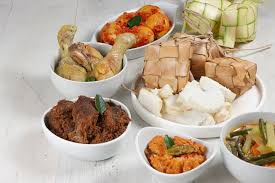History and Special Features of Eid al-Fitr Menu
The Origin of Eid al-Fitr Dishes
Eid al-Fitr is not only a moment of victory after fasting for a whole month, but also an opportunity to gather with family and enjoy various special dishes. The history and specialties of the Eid al-Fitr menu are closely related to Islamic culture and traditions that have developed in various parts of the world. Throughout history, Muslims in the Middle East have known the tradition of breaking the fast with special foods which later developed into the main menu during the Eid al-Fitr celebration.
Dishes such as ketupat, rendang, and opor ayam are not just ordinary foods. History records that the tradition of cooking ketupat began in the era of the Wali Songo, especially Sunan Kalijaga, who introduced this food as a symbol of purity and togetherness. The history and specialties of the Eid al-Fitr menu are also influenced by the mixing of cultures from various regions, creating a variety of menus that are increasingly rich and diverse.
Ketupat: Symbol of Purity and Nusantara Tradition
Ketupat is one of the obligatory dishes in the history and specialties of the Eid al-Fitr menu in Indonesia. Made from rice wrapped in woven coconut leaves, ketupat has a deep philosophy. Its unique shape symbolizes patience and resilience in living life. In addition, the woven fibers on ketupat depict the complexity of human life which is full of mistakes and sins, which are then cleansed when Eid al-Fitr arrives.
In Javanese tradition, ketupat is often served with chicken opor and sambal goreng ati. In other regions, such as Sumatra and Kalimantan, ketupat is also combined with rendang or curry typical of the region. The existence of ketupat in the history and specialty of the Eid al-Fitr menu shows how the acculturation of Islamic culture with local wisdom has formed a culinary specialty that has survived until now.
Opor Ayam: Rich Coconut Milk Soup
The history and specialty of the Eid al-Fitr menu would not be complete without mentioning opor ayam. This dish originates from the culinary tradition of the Archipelago that has existed since the time of the Hindu-Buddhist kingdoms in Indonesia. When Islam developed, opor ayam remained one of the main dishes served on holidays as a symbol of prosperity and togetherness.
The specialty of chicken opor lies in its coconut milk sauce which is rich in spices. Coconut milk provides a soft and savory texture, while a mixture of spices such as turmeric, galangal, and lemongrass provide a distinctive aroma that is appetizing. In the history and specialty of the Idul Fitri menu, chicken opor is often eaten with ketupat to create a harmonious combination of savory, sweet, and slightly spicy flavors.
Rendang: Minang Culinary Heritage that is Famous Worldwide
Not only famous in Indonesia, rendang is also one of the best foods in the world according to various international culinary surveys. The history and specialty of the Eid menu are increasingly colorful with the presence of rendang, which originates from the Minangkabau tradition. This dish used to only be served at big events, including Eid, as a symbol of wealth and prosperity.
The specialty of rendang lies in the cooking process which takes a long time. Beef is cooked in coconut milk and spices for several hours until the spices are completely absorbed. This process produces tender and flavorful meat. In the history and specialty of the Eid menu, rendang is often the main choice because it can last longer than other dishes, making it ideal to serve to guests who visit during Eid.
Read Also: Tight Competition in MotoGP 2025: Hot New Rivalry!
Sambal Goreng Ati: A Complement that Tempts the Appetite
Sambal goreng ati is a side dish that often appears in the history and specialty of the Eid menu. Made from chicken or beef liver cooked with potatoes and chili seasoning, this dish provides a spicy and savory sensation that complements the taste of ketupat and chicken opor.
The specialty of sambal goreng ati lies in the combination of textures and flavors. Soft chicken liver combined with crispy potatoes, and spicy and sweet chili seasoning, creates a harmony of flavors that are very much liked by many people. In the history and specialty of the Eid menu, sambal goreng ati is not only a side dish but also a symbol of the diversity of flavors in the Eid celebration.
Cookies: Sweet Treats on Eid

In addition to heavy meals, the history and specialty of the Eid menu also include various types of cookies that are mandatory snacks during Eid. Nastar, kastengel, putri salju, and lidah kucing are some examples of cookies that are always present on the guest table.
Cookies have a long history in Indonesian cuisine. Nastar, for example, is an adaptation of a pineapple cake from the Netherlands which was then adapted to local tastes. Kastengel also comes from the Dutch colonial influence, but is now part of history and a specialty of the Idul Fitri menu that cannot be missed. The sweetness of these cookies is the perfect complement after eating heavy dishes such as ketupat and rendang.
Refreshing Special Drinks
Not only food, the history and specialty of the Eid menu also involve refreshing special drinks. Melon ice, mixed ice, and cocopandan syrup are often the main choices to quench thirst after eating Eid food.
One of the popular drinks is cucumber ice, which has a soft texture and natural sweetness. Its existence in the history and specialty of the Eid menu shows that this drink has become part of the Eid tradition in many regions. In addition, warm sweet tea is also often served to accompany warm chats with family and visiting guests.
The Uniqueness of Eid Dishes in Various Regions
Each region in Indonesia has its own variations in the history and specialty of the Eid menu. In Aceh, for example, there is a special goat curry cooked with strong spices. In Sulawesi, special dishes such as buras and coto Makassar are often present on the dining table during Eid.
In some areas, there are even unique traditions such as eating together on banana leaves, which reflect the value of togetherness in the history and specialness of the Eid menu. Not only that, many families have also begun to adopt modern dishes as part of the celebration, creating a combination of traditional and contemporary cuisine.
The celebration of Eid al-Fitr cannot be separated from the history and specialness of the diverse Eid menu. From ketupat to cookies, each dish has its own story and meaning. It is no wonder that every year, many people compete to prepare the best menu to enjoy with family and relatives. In fact, many restaurants and catering services such as Ampmwin Link also provide various special Eid dishes to meet the demands of the community who want to enjoy special dishes without having to bother cooking themselves.


